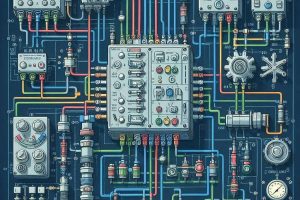Commissioning electrical and industrial systems is a critical process that ensures everything works correctly, safely, and efficiently before regular operation begins. Whether you’re a seasoned professional or new to the field, following established commissioning principles can save time, money, and potentially lives. This comprehensive guide breaks down over 100 essential rules organized into clear categories to help you navigate the commissioning process successfully.
What is Commissioning and Why Does It Matter?
Before diving into the rules, let’s understand what commissioning is and why it’s so important. Commissioning is the systematic process of verifying that all systems and components of a building or industrial plant are designed, installed, tested, and maintained according to the operational requirements of the owner or final client.
Proper commissioning:
- Ensures safety for personnel and equipment
- Reduces operational costs and downtime
- Extends equipment life
- Maintains compliance with regulations
- Provides documented proof of system performance
Now, let’s explore the rules that will guide you to commissioning success.
Core Testing Principles
These fundamental principles form the foundation of effective commissioning:
- If you didn’t test it, don’t trust it. Never assume any system is operational just because it powers on.
- Drawings can lie. Devices don’t. What looks perfect on paper may not match reality in the field.
- Power doesn’t equal function. A powered device isn’t necessarily a properly functioning one.
- Never assume signal direction or scaling. Just because values look correct on displays doesn’t mean they align with actual field device outputs.
- The field always wins—check everything. Real-world conditions ultimately determine what works, regardless of how thorough your plans are.
- Test everything twice. Verification testing confirms consistency and reliability.
- Trust but verify vendor specifications. Always validate manufacturer claims in the actual installation environment.
- The first test is often wrong. Environmental factors, setup errors, or measurement issues frequently affect initial results.
- No golden screwdrivers. Never make adjustments without proper documentation and authorization.
- Documentation before modification. Always record the initial state before making any changes.
Planning & Preparation
Proper planning prevents poor performance. These rules help you prepare effectively:
- Begin with the end in mind. Define what success looks like before starting commissioning.
- Establish clear acceptance criteria. Know exactly what measurable parameters constitute successful commissioning.
- Review all relevant standards and codes. Ensure compliance with local and international requirements.
- Create a detailed commissioning plan. Include timelines, resources needed, and contingency plans.
- Conduct a pre-commissioning meeting. Ensure all stakeholders understand their roles and responsibilities.
- Sequence matters. Commission systems in a logical order based on dependencies.
- Identify critical paths. Know which systems must be commissioned first to enable others.
- Gather all required tools before starting. Ensure calibration certificates are current.
- Ensure spare parts availability. Critical components should be on-site during commissioning.
- Create system-specific checklists. Generic lists often miss important system-specific checks.
Documentation Requirements
If it isn’t documented, it didn’t happen:
- No test is complete until it’s documented. Undocumented tests might as well not have occurred.
- Record ambient conditions. Temperature, humidity, and other environmental factors can affect system performance.
- Document as-built deviations. Note any differences between design and actual installation.
- Use revision control for all documentation. Always know which version is current.
- Create component inventory lists. Include model numbers, serial numbers, and firmware versions.
- Maintain a commissioning log. Record daily activities, challenges, and solutions.
- Take photographs of key installations. Visual records are invaluable for future reference.
- Include terminal connection diagrams. Don’t rely solely on schematic diagrams.
- Document instrument calibration details. Include calibration method, reference standards, and date.
- Create a deficiency tracking system. Record issues found, responsibility for resolution, and verification of fixes.
Electrical System Rules
These rules keep your electrical systems safe and reliable:
- Verify voltage at every connection point. Don’t assume voltage is constant throughout the system.
- Check phase rotation before connecting loads. Incorrect rotation can damage equipment.
- Test ground fault protection systems. Ensure they operate at the specified current levels.
- Verify insulation resistance values. Degraded insulation can lead to system failures.
- Check power quality parameters. Harmonics, power factor, and transients can affect system operation.
- Measure actual load currents. Compare with design values and equipment ratings.
- Test all protective relays. Verify proper operation at trip points.
- Check for voltage imbalance. Imbalance can cause motor overheating.
- Test emergency power transfer systems. Verify proper operation under all scenarios.
- Verify UPS performance under load. Check actual runtime against specifications.
Control System Rules
Automation and control systems need special attention:
- Test each control loop individually. Then test for interactions between loops.
- Verify PLC I/O mapping. Each physical connection should match the program.
- Test control logic under abnormal conditions. Ensure proper response to out-of-range inputs.
- Check all alarm setpoints. Verify both activation and reset points.
- Test communication between systems. Verify data integrity across interfaces.
- Perform failure mode testing. Verify system behavior under power loss and component failure.
- Check scan times under load. High scan times can cause control issues.
- Verify security access levels. Ensure appropriate restrictions for different users.
- Test manual overrides. Verify they function as intended without unintended consequences.
- Validate HMI displays against actual values. Ensure what operators see is accurate.
Mechanical System Rules
The physical components need just as much attention:
- Verify proper rotation of all motors. Check before extended operation.
- Measure vibration levels at startup. Establish baseline for future comparison.
- Confirm flow rates in all fluid systems. Compare actual versus design values.
- Check for leaks under pressure. Systems may appear tight until fully pressurized.
- Verify temperature control systems. Check both heating and cooling functions.
- Test all safety interlocks. Ensure they cannot be easily bypassed.
- Measure actual pressure drops. Compare with calculated values.
- Check valve operation throughout full range. Verify smooth operation at all positions.
- Test emergency shutdown systems. Verify they operate as designed under all conditions.
- Verify proper ventilation. Ensure air changes meet design specifications.
Instrument & Measurement Rules
Accuracy in measurement ensures system integrity:
- Calibrate instruments in the installed position. Position can affect calibration.
- Test instruments at multiple points. Don’t assume linearity between zero and span.
- Verify signal integrity throughout control system. Check for signal degradation.
- Test redundant instruments independently. Ensure they truly provide redundancy.
- Check instrument response times. Slow response can affect control stability.
- Verify units of measurement consistently. Mismatched units cause calculation errors.
- Test limit switches at actual limit positions. Don’t rely on specifications.
- Verify analog scaling in the control system. Raw values should convert to proper engineering units.
- Test instruments under normal operating conditions. Performance may change with process conditions.
- Document instrument ranges and calibration span. Future troubleshooting will need this information.
Network & Communications Rules
Modern systems rely heavily on reliable networks:
- Test network bandwidth under maximum load. Verify sufficient capacity for all traffic.
- Check network redundancy. Simulate failures to verify automatic switchover.
- Verify all protocol converters. Ensure data integrity across different protocols.
- Test communication timeouts. Verify system response to lost communications.
- Document IP addresses and network configurations. Include subnet masks and gateway addresses.
- Verify wireless coverage throughout the facility. Check for dead spots.
- Test network security measures. Verify firewalls and access controls function as designed.
- Check time synchronization across all systems. Timestamp inconsistencies can complicate troubleshooting.
- Test remote access systems. Verify both functionality and security.
- Document network topology. Include physical and logical connections.
Safety & Compliance Rules
Safety is never optional:
- Test all emergency stops. Verify they work under all operating conditions.
- Verify safety interlocks cannot be bypassed. Test bypass monitoring systems.
- Test fire and gas detection systems. Include response to actual or simulated inputs.
- Verify compliance with hazardous area requirements. Check certifications and installation details.
- Test personal protective equipment alarms. Ensure they activate at appropriate levels.
- Verify pressure relief systems. Test operation at specified pressures.
- Check safety critical documentation. Ensure it’s complete and available to operators.
- Test backup systems. Verify automatic and manual transfer capabilities.
- Verify safety instrumented systems. Test to the specified safety integrity level (SIL).
- Document safety system test results. Regulatory compliance may require this documentation.
Handover & Training Rules
A smooth transition to operations is crucial:
- Train operators on normal operation. Include startup, shutdown, and routine adjustments.
- Train maintenance personnel on troubleshooting. Include common failure modes and diagnostics.
- Create clear operating procedures. Include normal, abnormal, and emergency operations.
- Develop a preventive maintenance schedule. Base intervals on manufacturer recommendations and site conditions.
- Verify spare parts inventory. Ensure critical spares are available and properly stored.
- Create a system owner’s manual. Include all relevant documentation in one place.
- Conduct formal system handover. Include customer sign-off on performance.
- Document outstanding issues. Include plan and timeline for resolution.
- Establish warranty start dates. Document when guarantee periods begin.
- Plan for performance verification testing. Schedule follow-up testing after a period of operation.
Continuous Improvement Rules
The commissioning process itself should evolve:
- Document lessons learned. Capture insights for future commissioning projects.
- Compare actual performance to design. Identify opportunities for optimization.
- Review commissioning procedures. Continuously improve the process.
- Establish performance benchmarks. Use for comparison during routine maintenance.
- Create a feedback loop with design. Ensure field experience informs future designs.
- Document system optimization opportunities. Some improvements may be implemented post-commissioning.
- Maintain a knowledge base. Record solutions to uncommon problems.
- Establish trigger points for recommissioning. Define when systems should be fully retested.
- Implement a continuous monitoring plan. Identify performance drift before it becomes critical.
- Schedule periodic system audits. Verify systems maintain their commissioned performance.
Conclusion
Proper commissioning is an investment that pays dividends throughout the life of your electrical and industrial systems. By following these rules, you’ll ensure your systems start on the right foot and continue to perform optimally for years to come.
Remember that commissioning isn’t just a checkbox exercise—it’s a comprehensive process that requires attention to detail, technical expertise, and systematic documentation. When done correctly, it provides peace of mind that your systems will operate safely, efficiently, and as designed.
Whether you’re commissioning a simple electrical installation or a complex industrial facility, these rules provide a solid foundation for success. Adapt them to your specific needs, but never compromise on the core principles of thorough testing, documentation, and verification.
This article was compiled based on industry best practices and expanded from the original “5 Rules of Commissioning” by Michael Akparibo Alung.


